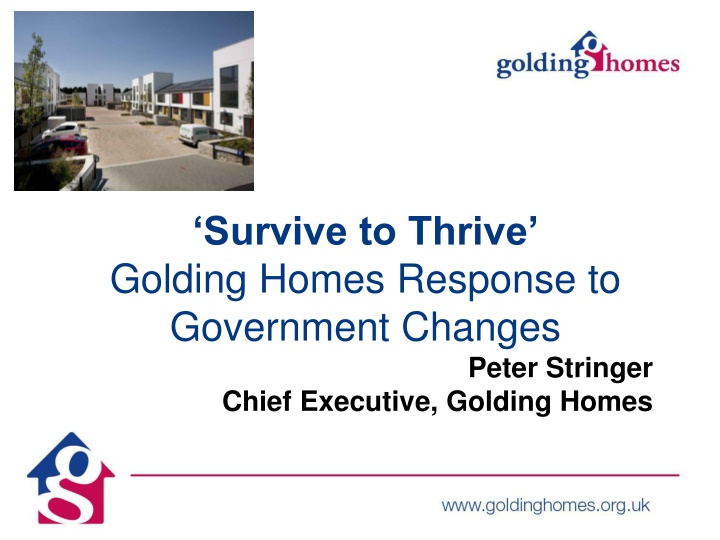
Survive to Thrive: Impact of Government Changes on Golding Homes Response
Explore Golding Homes' strategic response to government changes impacting their financial plans, new home developments, and income projections. Learn about the challenges faced and decisions to maintain financial stability and service excellence.
Download Presentation

Please find below an Image/Link to download the presentation.
The content on the website is provided AS IS for your information and personal use only. It may not be sold, licensed, or shared on other websites without obtaining consent from the author. If you encounter any issues during the download, it is possible that the publisher has removed the file from their server.
You are allowed to download the files provided on this website for personal or commercial use, subject to the condition that they are used lawfully. All files are the property of their respective owners.
The content on the website is provided AS IS for your information and personal use only. It may not be sold, licensed, or shared on other websites without obtaining consent from the author.
E N D
Presentation Transcript
Survive to Thrive Golding Homes Response to Government Changes Peter Stringer Chief Executive, Golding Homes
About us : a few facts Treasury Borrowing 170m Turnover 34.3m New Homes Programme 200 per annum Operating Surplus 31% Staff 182 Board 10 Executive Management Team 4
Business Strategy 2015-20 Priority 1 Growing the number of homes we provide Priority 2 Investing in assets and communities Priority 3 Retaining our financial strength Priority 4 Delivering excellent customer service Priority 5 Developing awareness of our work amongst our people and partners
Impact on GOLDING HOMES .
Impact: Business Plan We assumed rent rise of 3% (CPI+1%) for each year HOWEVER . Income reduction by 1.2m in year one reduction by 5m by year five (-14%) reduction by 30% reduction by 60m reduction to 5m from 10m increase by 1.5m impact uncertain Asset valuation Borrowing capacity Annual surplus Bad debt costs RTB2 and Pay to Stay
Impact: Development of New Homes 10 year programme Tenure Before No After No % % Social rent 50 25 Nil 0 Affordable rent 60 30 30 20 Shared ownership 40 20 45 30 Market rent 40 20 45 30 Outright sale 10 5 30 20 Total annual programme 200 100 150 100 Assumes 2.5m PA savings Assumes no RTB2 replacements Reduces new homes by 25% PA and no social rented homes!
Impact: Financial Plan - revised assumptions post-budget Description % Pre-budget 2015- 2016 % Post-budget 2016- 2020 Rent increase 2.2 -1 * Inflation 2.3 2 Cost increases above inflation 0.5 0 Employee cost increases 0.5 0.5 Libor 1.1 4 * Assume CPI only (2%) rent increases from 2020/21 onwards Assume 1000 new homes in management with no growth in staff headcount!
Big question for housing associations How do we replace loss of income? Do we . Recover all lost income from savings? OR Absorb losses and stop developing new homes?
Can we grow our income? Stock rationalisation more acquisitions from other HAs Homes for sale Asset disposals Services charges and new sources Commercial activity (market rent, shops) Stock transfer Take over - smaller HAs
Can we reduce our annual operating costs by 2.5m? Reduce interest costs Smarter procurement Asset management Development strategy Doing things differently Lean thinking things we should STOP DOING Channel shift to Digital First Strategic options (merger/service-sharing) Staff structures
Survive to Thrive: we will not Rely on uncertain revenue streams Duplicate effort Pursue customer satisfaction at all costs Do projects that don t support our vision Ignore the link between investment in existing homes and overall customer satisfaction
Survive to Thrive: we will Recognise that scale is vital to future success Put more emphasis on efficiency and resilience Embrace organisational change Consider deregistration? Recognise the tension of being more commercial against our social purpose Segment our offer based upon customer intelligence
Survive to Thrive: we will Favour more ownership initiatives and products Manage risk Focus on digital self-service Create pathways to employment Intervene (housing management) less and enable (community investment) more
A few questions for discussion How do we manage the tension between a need to be more commercial whilst retaining our social purpose ? What activities should we stop doing? In the drive to digital world, do we have smart customer intelligence that will allow us to segment our offer? How might the deregulation of Housing Associations introduce new tensions in the relationship with Local Authorities?
Thank you Peter Stringer Chief Executive, Golding Homes 0300 777 2600 Peter.Stringer@goldinghomes.org.uk Twitter: @goldinghomes www.facebook.com/goldinghomes
